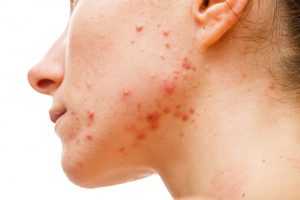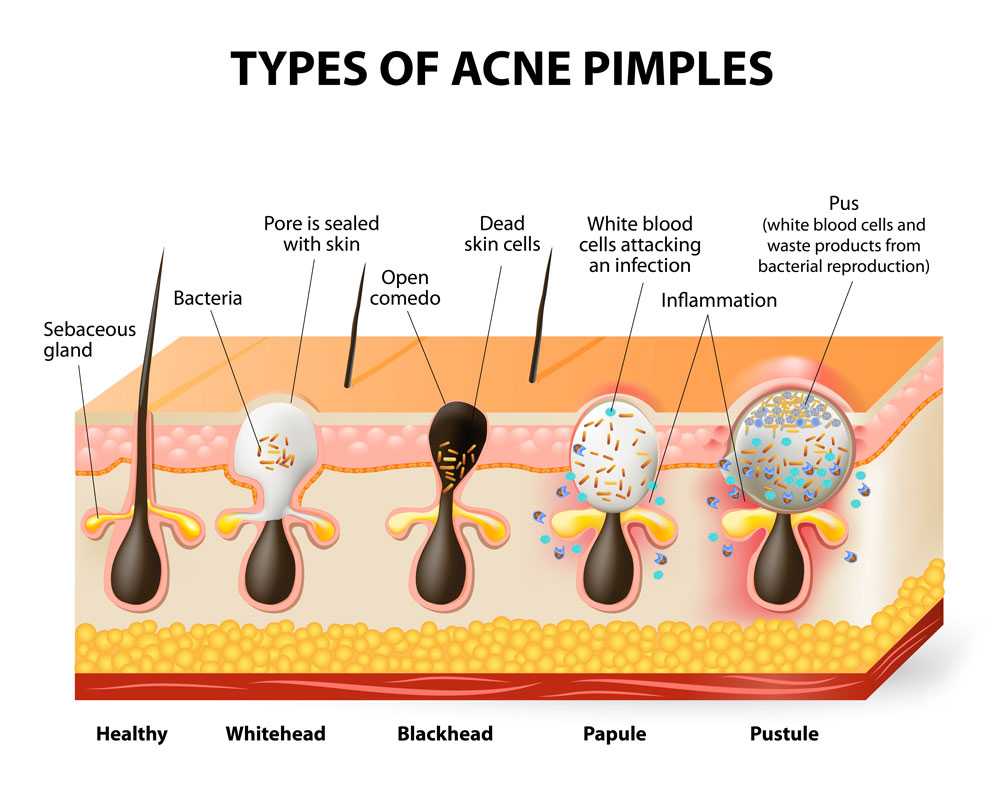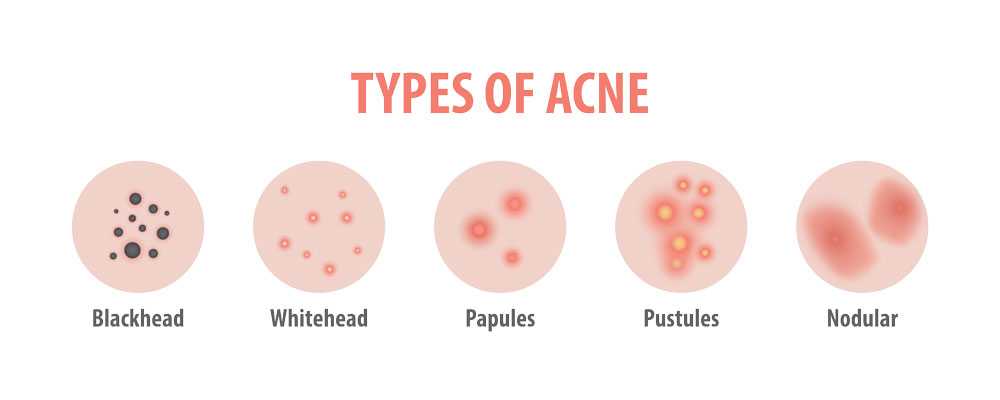What is Acne?
 Acne is the most common skin disease in America. Up to 60-70% of Americans have been afflicted with acne in some point of their lives. Severe acne, deep breakouts in the skin that result in permanent physical and mental scarring, effect up to 20% of this effected populace.
Acne is the most common skin disease in America. Up to 60-70% of Americans have been afflicted with acne in some point of their lives. Severe acne, deep breakouts in the skin that result in permanent physical and mental scarring, effect up to 20% of this effected populace.
Acne is characterized by skin blemishes that can be painful, and visually upsetting to those afflicted.
Acne’s symptoms can present on the skin in several different forms including, blackhead, whiteheads, pimples, pustules, and more.
What Causes Acne?
Acne blemishes appear where hair follicles protrude from the skin. Acne is caused when the pores around the hair follicles get clogged preventing the sebaceous gland in the dermis layer of the skin from releasing sebum oil to the surface. Pores can be blocked by dead skin cells, bacteria, or excess oil.
Depending on the severity of these blockages them acne can present as whiteheads, blackheads, papules, and pustules.
There are also several factors that increase a person’s likelihood to get acne.
Genetics: Genetics is key factor on whether an individual will have acne or not. Skin sensitivity, inflammatory response, and even the amount of sebum oil (an oily substance produced by fat-producing cells) production are all genetic factors. If one parent has acne, 1 out of 4 of their children will also have acne symptoms. If both parents have acne, 3 out of 4 of their children are likely to have acne.
Excess Oil Production: In the dermis layer of the skin, the base of the hair follicles has the sebaceous glands. These glands secrete a lubricating oil into the hair follicles called sebum, which lubricates and waterproofs the skin. Sometimes the sebaceous glands could produce excess sebum, which clogs the skins pores resulting in acne.
Diet: Researchers have found some correlations between diet and acne. Studies have shown there are links between acne symptoms and consumption of vitamin A in milk and carbohydrate rich foods like bread and chips. Anecdotal evidence suggests that there is a link between acne and chocolate, but there hasn’t been any significant research to correlate this finding.
Eating Greasy Foods with High Amount of Oil: Cheeseburgers and pizza have not been proven to increase acne symptoms. However, those who prepare these foods, who get this oil directly on their skin have increased likelihood of acne.
Bacteria: Acne is the presence of bacteria (Propionibacterium acnes)
Hormones: Changes in hormone levels can increase the likelihood of acne production. Fluctuations in hormones from conditions like puberty of pregnancy may cause the sebaceous gland to increase their production of sebum.
Stress: Acne is linked to stress. Both anecdotal accounts and a Stanford study in 2003 shows a correlation between stress and acne. It is unclear as to the causation, but evidence indicates an increased production of sebum during periods of stress. (Annie Chiu, Susan Y. Chon, & Alexa B. Kimball, 2003)
Medications: Certain medications have side effects that can cause acne or acne-like symptoms. In most cases these side effects are unlikely. However, there is still a chance that lithium, anticonvulsants, barbiturates, corticosteroids, DHEA, lithium, and medications that contain bromides or iodides may cause an acne outbreak.
Symptoms of Acne
Acne presentation vary greatly in severity between individuals, but some of the physical symptoms include:
Papules
Papules are small red painful bumps on the skin
Pimples
Pimples (pustules) are papules filled with pus on the tips
Whiteheads
Whiteheads are plugged pores that have a layer skin over them
Blackheads
Blackheads are plugged pores that are exposed to air causing the clogged material to oxidize and darkened
Nodules
Nodules are large, solid, painful lumps beneath the surface of the skin
Acne Treatments Available
Although there isn’t a way to completely prevent acne, Epiphany Dermatology and Medical Day Spa provides several treatments to eliminate acne blemishes. It is important to treat early and aggressively to prevent scarring, or excessive increase in pigmentation on the affected areas of the skin.
It is our priority to ensure that every one of our clients gets individual skin evaluation so that they can get a customized skin care plan that best suits their needs. To best understand your skin care needs, we recommend a Visia Skin Consultation. The VISIA Skin Analysis System is a high-tech imaging system that provides an easy-to-understand, objective evaluation of your skin.
After the Visia Skin Consultation, we would recommend one or all the following treatments:
Facial: Facials are a strong starting point because of its deep pore cleansing ability. Deep Pore Cleansing Facial gives your skin the deep clean it needs. It restores balance and purifies your skin with cleansing, thorough exfoliation, extractions, and a mask suitable for your skin type.
HydraFacial: HydraFacial’s are not only relaxing, but it provides a deep pore cleanse that rinses and removes unwanted skin debris, and extracts blackheads and whiteheads.
Microdermabrasion: Microdermabrasion is a non-invasive procedure that deeply exfoliates and refines the surface of the skin, leaving it brighter, smoother and more youthful looking. Suitable for all skin types, microdermabrasion’s can help treat fine lines, uneven skin texture, enlarged pores, and stimulates blood flow to the face.
If you’re suffering from acne scars left post breakout, Epiphany Dermatology recommends Fraxel Laser Treatment.
Fraxel Dual Laser Treatment works by utilizing dual lasers with frequencies that reach the epidermis and dermis layers of the skin. The laser penetrates the damaged skin and stimulates the collagen and new healthy skin cells to grow.
Acne Scars are Formed in the Second Layer of the Skin Called the Dermis
The most common types of acne scars are:
Rolling Scar: These scars are formed by extra tissue production after the acne started to heal, leaving a rolling appearance on top of the skins. These types of scars are more typical for people who have suffered from acne for long periods of time. Such as youth and adult acne.
Boxcar Scar: These scars are formed from the breakdown of collagen and have a less aggressive look compared to an ice pick scar. These scars can become permanent if not treated due to the increased breakdown of collagen and the loss of elastic in the skin.
Ice Pick Scar: The most common of acne scars. These scars are deep and narrow, like the skin was poked with the tip of an ice pick. These types of scars give the appearance of small holes or pits in the face. In some instances, they do heal by themselves, but it can take years to see them shrink.
Fraxel Laser Treatments focus on the acne scar and stimulates the skin to create more collagen and rebuilding the skin cells elasticity. Most people can see results within the first 2 treatments.
Schedule Your Acne Treatments at Epiphany Dermatology – Kansas City
Acne Treatments are performed by Licensed Aestheticians overseen by Board-Certified Dermatologists at both our Riverside and St. Joseph, MO Locations.
Our Riverside Location:
805 NW Platte Rd., Suite 120
Riverside, MO 64150 | CLICK HERE for Directions
Phone: (816) 205-8120
SEND US AN E-MAIL
Our St. Joseph Location:
805 N 36th St., Suite D
St. Joseph, MO 64506 | CLICK HERE for Directions
Phone: (816) 205-8120
SEND US AN E-MAIL



